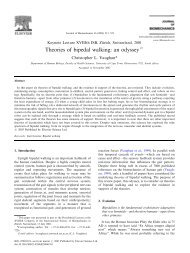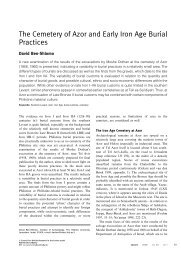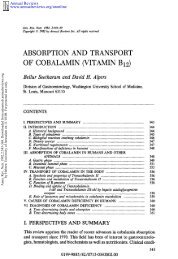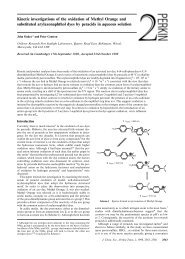The Riddle of Ramat Raḥel: The Archaeology of a Royal Persian ...
The Riddle of Ramat Raḥel: The Archaeology of a Royal Persian ...
The Riddle of Ramat Raḥel: The Archaeology of a Royal Persian ...
Create successful ePaper yourself
Turn your PDF publications into a flip-book with our unique Google optimized e-Paper software.
17Fig. 4 – Storage Jars found at Pit 13174, dated to the sixth-fifth century BCE (Photo by P. Shargo)<strong>The</strong>se finds, together with hundreds <strong>of</strong> stamp impressions on jar handles dated to the <strong>Persian</strong> andHellenistic occupation periods at the site, are the best indication that <strong>Ramat</strong> <strong>Raḥel</strong> was the maincenter <strong>of</strong> the yhwd system in which the jars circulated. This <strong>Persian</strong> period system <strong>of</strong> stamping jarhandles continued the lmlk and rosette systems <strong>of</strong> stamped handles from the late Iron Age and thelion stamped handles from the Babylonian period.In this regard, the place <strong>of</strong> the lion stamp impressions on the body or the handles <strong>of</strong> jarsdeserve special attention. Seventy-seven lion stamped jar handles were excavated at <strong>Ramat</strong> <strong>Raḥel</strong>,out <strong>of</strong> a total <strong>of</strong> about 110 stamped handles known to us to date (Lipschits 2010). Furthermore, amodified typological classification demonstrates that two out <strong>of</strong> 10 types were found solely at<strong>Ramat</strong> <strong>Raḥel</strong>, one additional type was found at <strong>Ramat</strong> <strong>Raḥel</strong> and Nebi Samwil only, and that allthe other types are represented mainly at <strong>Ramat</strong> <strong>Raḥel</strong> (ibid).<strong>The</strong> lion stamp impressions can no longer be dated to the very beginning <strong>of</strong> the <strong>Persian</strong>period. 6 A new study <strong>of</strong> the iconography <strong>of</strong> this type hints at the connection <strong>of</strong> these objects withthe Assyrian-Babylonian world and interpret this “object” as a human head in pr<strong>of</strong>ile, just as it iswell known from the Babylonian world (Ornan 2010; Sass 2010). Furthermore, petrographicanalysis <strong>of</strong> the lion stamped handles shows a resemblance <strong>of</strong> the rosette jar handles to Iron Agepatterns (pottery production in the Shephelah <strong>of</strong> Judah and in the area <strong>of</strong> Jerusalem) rather than to<strong>Persian</strong>-period patterns <strong>of</strong> the yhwd jars (pottery production solely in the area <strong>of</strong> Jerusalem) (Grossand Goren 2010: 11-12).6 <strong>The</strong> reason for dating the lion stamp impressions to the early <strong>Persian</strong> period is the absence <strong>of</strong> these stamped handles fromthe “classic” <strong>Persian</strong> period strata on the one hand, and the historical assumption that they cannot be dated to the pre-<strong>Persian</strong> period (i.e., to the “Exilic period”) on the other. Besides, Stern (1982: 209-210; 2001: 541; cf. to Ariel andShoham 2000: 141) interpreted the “object” or “indistinct signs”, which is part <strong>of</strong> a scene depicting a lion standing on hishind legs, with the two front legs stretched out wide, as an Achaemenid “fire altar.”







